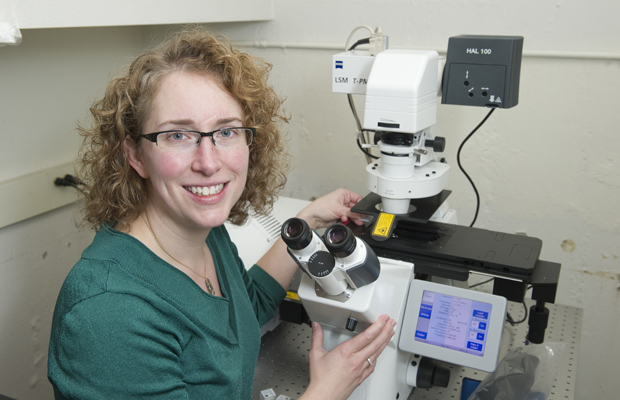3Qs: Getting under your skin to monitor health

For years, Heather Clark, an associate professor of pharmaceutical sciences in Northeastern University’s Bouvé College of Health Sciences, has been hard at work developing nanosensors that can be injected under a patient’s skin and can monitor health in a variety of ways. She and bioengineering doctoral student Matthew Dubach have now coauthored a paper in the Proceedings of the National Academy of Sciences journal with MIT chemical engineer Karen Gleason. The paper expands the boundaries of Clark’s research by merging technology and medicine.
What research did you explore for this paper?
We present our work creating novel sensors that can be injected under the skin to fluorescently monitor sodium concentrations in the blood. These sensors are unique in that they have a long hair-like structure that prevents them from spreading once they’re injected, and they have also a biocompatible coating. Our collaborators created tubes that we fill with our sensor material to produce the microworm sensors, and the fluorescent material allows for monitoring sodium concentrations right through the skin as the material glows.
How does this research build on your previous work?
We have previously reported on using nanoparticle sensors for detecting sodium levels in cells and in the body. But creating microworms allows us to control the coating of the sensors. Also, since the structure has a large radius and a large surface-area-to-volume ratio, the sensors won’t diffuse away once they’re injected. This is ideal because the sensors will stay in one location and report sodium concentration levels immediately.
What are your hopes for how this innovative research will positively impact global health now and in the future?
We hope to provide a method to track critical biomedical information in a relatively pain-free way—both in the hospital and through self-monitoring at home—without having to draw blood. For example, chronically hyponatremic patients, who suffer from an electrolyte disorder, need to check their sodium levels to prevent confusion or dizziness. Hyponatremia is a major concern among the elderly population. Furthermore, we hope to expand our sensing material to create microworm sensors for monitoring glucose levels, which could be extremely beneficial to diabetic patients.
Northeastern bioengineering doctoral student Matthew Dubach and MIT postdoctoral researcher Gozde Ozaydin-Ince were also coauthors on the paper.





